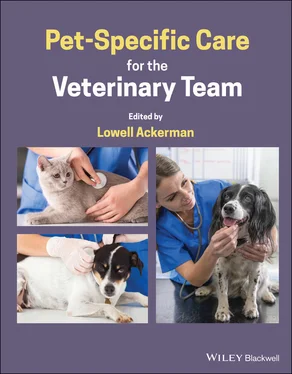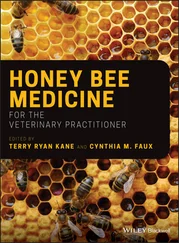4 4 Hardie, E.M., Roe, S.C., and Martin, F.R. (2002). Radiographic evidence of degenerative joint disease in geriatric cats: 100 cases (1994–1997). J. Am. Vet. Med. Assoc. 220 (5): 628–632.
5 5 Lopes Fagundes, A.L., Hewison, L., McPeake, K.J. et al. (2018). Noise sensitivities in dogs: an exploration of signs in dogs with and without musculoskeletal pain using qualitative content analysis. Front. Vet. Sci. 5: 17.
1 Canine Brief Pain Inventory (Canine BPI). www.vet.upenn.edu/research/clinical‐trials‐vcic/our‐services/pennchart/cbpi‐tool
2 Hielm‐Björkman, A.K., Rita, H., and Tulamo, R.M. (2009). Psychometric testing of the Helsinki chronic pain index by completion of a questionnaire in Finnish by owners of dogs with chronic signs of pain caused by osteoarthritis. Am. J. Vet. Res. 70 (6): 727–734.
3 Valentin, C. (2009). Cincinnati Orthopaedic Disability Index in canines. Australian Journal of Physiotherapy 55: 288. www.sciencedirect.com/science/article/pii/S0004951409700145.
4 Feline Musculoskeletal Pain Index. https://cvm.ncsu.edu/research/labs/clinical‐sciences/comparative‐pain‐research/labs‐comparative‐pain‐research‐clinical‐metrology‐instruments‐feline‐musculoskeletal‐pain‐index
5 Klink, M.P., Gruen, M.E., del Castillo, J. et al. (2018). Development and preliminary validity and reliability of the Montreal instrument for cat arthritis testing, for use by caretaker/owner, MI‐CAT(C), via a randomised clinical trial. Applied Animal Behaviour Science 200: 96–105. www.sciencedirect.com/science/article/abs/pii/S0168159117303271.
3.13 Breed Predisposition
Nan Boss, DVM
Best Friends Veterinary Center, Grafton, WI, USA
 BASICS
BASICS
3.13.1 Summary
Different breeds have different predispositions to disease states caused by genetic variants. Any personalized care plan should incorporate screening, treatment plans, and client education based on susceptibility to genetic diseases. There is a large opportunity for practices to improve both patient care and professional outcomes via breed‐specific programs.
 MAIN CONCEPTS
MAIN CONCEPTS
A great deal of the illness seen in dogs and cats is breed related (see 11.4Heritable Health Conditions – By Breed). All breeds of dogs and cats have genetic susceptibility to particular medical and behavioral problems. In addition, any individual pet carries genes for diseases it may never develop itself but that could be passed down to its offspring.
Many canine and feline genetic diseases have been described to date (see 11.3Heritable Health Conditions – By Disease). Many purebred cats have serious genetic problems and even most plain old domestic shorthair or longhair cats have susceptibility to genetically related diseases.
Mixed‐breed dogs are not immune to genetically related diseases either (see 3.19Mixed‐Breed Considerations). A study by researchers at the University of California‐Davis [1] challenged the theory that purebred dogs are more prone to genetic disorders than mixed breed dogs. They studied 27 254 dogs with inherited disorders over a five‐year period. For 10 out of the 24 disorders studied, purebred dogs were more likely to develop the disorder. For 13 of those disorders, mixed‐breed and purebred dogs had equal risk. For cranial cruciate ligament tear, mixed‐breed dogs were actually at higher risk than purebreds.
Some of these diseases are very common and some are very rare. Some are common in one breed and rare in another. Breeds from similar lineages are more susceptible to certain disorders that affect closely related purebreds. Disorders with equal prevalence in purebreds and mixed‐breeds seem to be more ancient mutations that are widely spread through the pet population.
Some genetic diseases are dangerous and deadly while others are minor flaws easily dealt with (see 2.7Risk Assessment).
Some heritable diseases can be tested for, either with DNA tests or more standard types of phenotypic testing, enabling earlier diagnosis and intervention (see 3.4Predicting and Eliminating Disease Traits and 3.11 Integrating Genotypic and Phenotypic Testing). Disorders caused by a single genetic defect can usually be more easily diagnosed and treated, and more and more genetic (DNA) tests are becoming available all the time. Collectively, early detection testing helps us tailor a pet's healthcare plan to its own particular circumstances (see 4.7Embracing Early Detection).
Some of these genetic disorders simply require awareness on the part of the owner as to what to watch for and when to call the veterinarian. Our goal should be to make sure that every owner of an at‐risk breed knows about the diseases and problems that could affect their dog or cat, both genetically related and not, and the testing or treatment that is currently available for them (see 6.4Creating a Pet‐Specific User's Manual).
3.13.2 Screening for Genetic Diseases
The fact that a pet is not a purebred does not mean that genetic diseases shouldn't be screened for. Diseases caused by recessive genes are less likely to be problems in mixed‐breeds but many breeds share susceptibility to the same genetic defects, especially disorders with more complex inheritance that just a single gene mutation. Statistically, purebred dogs are not always less healthy than mixes and dominant genes can affect offspring regardless of how far from purebred they are (see link to video titled Mixed breed dogs have genetic risk too: www.youtube.com/watch?v=Ce1u_ZqwqMo).
We can sometimes infer susceptibility to genetic diseases just by looking at size or phenotype. We might expect any large or giant breed to have greater risk for hemangiosarcoma and hip dysplasia than a much smaller dog, although the risks are actually based on family history.
Gene defects may cause a direct problem every time, or they may be turned on or off by factors such as the pet's environment, diet, infection, medications or surgery. For example, a cat may have a genetic susceptibility to diabetes mellitus but may only develop the disease if it becomes overweight. A collie may have the MDR1 genetic defect that causes it to get sick from the drug ivermectin but if it never received that or other drugs implicated with this variant, the problem wouldn't be evident.
Fortunately, DNA screening can now tell us what breeds are likely in a pet's heritage as well as allowing us to test or screen for individual genetic diseases. Panels of DNA tests are available as well, so we can test for dozens or hundreds of DNA defects with a single sample of blood, saliva or cheek cells (see 3.6Genetic Testing). These test panels are inexpensive enough to be used widely as screening tools. Unlike other types of testing, such as thyroid screening, a DNA panel typically only needs to be done once in a pet's life.
Some care must be taken when selecting a laboratory for DNA testing. Manufacturers are not required to disclose their testing methodology nor is there any oversight of the laboratory running the test. Direct‐to‐consumer DNA tests are popular, but the results may be suspect. The WSAVA's Canine and Feline Hereditary Disease website (https://wsava.org/committees/hereditary‐disease‐committee/#:~:text=The%20World%20Small%20Animal%20Veterinary,now%20and%20in%20future%20generations) lists available DNA tests by breed, disease and testing laboratory, and provides links to peer‐reviewed citations. Organizations such as the Orthopedic Foundation for Animals ( www.ofa.org) and the International Partnership for Dogs ( www.dogwellnet.com) can provide advice on available testing. University‐run laboratories are usually highly qualified, though they generally run only individual tests versus panels.
Читать дальше

 BASICS
BASICS MAIN CONCEPTS
MAIN CONCEPTS










